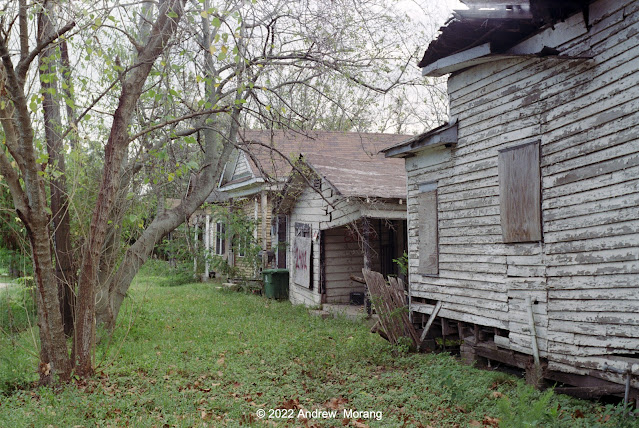Introduction
The Wards are former political subdivisions of Houston, Texas. They no longer officially exist but still represent approximate regions of the city. Their inhabitants associate with their home ward.
 |
| Houston Wards in 1920 (from Wikipedia, in the public domain) |
This 1920 map shows the Wards at that time. Note that Hermann Park is in the bottom center of the map, in the countryside then. A hospital was already at the south side of Hermann Park. Just south of this today is the huge Texas Medical Center, with world-famous hospitals including the University of Texas MD Anderson Cancer Center.
The little rectangle at the lower left is West University Place. The community, first developed in 1917, never became incorporated into the City of Houston. Today, West U is a fashionable and upper-crust community to call home.
Fourth Ward
 |
| Shotgun house, 1410 Robin Street (Ilford Delta 100 film, Rolleiflex 3.5E camera) |
 |
| Historic wood houses, 1320 Robin Street (Ilford Delta 100 film) |
Much of the Fourth Ward that I remember from the early 1980s has been totally transformed with modern townhouses and condominiums. A small cluster of wood houses on Robin Street is (or was) being preserved.
These buildings are in the Heritage Freedman's Town. This was the oldest African-American part of Houston and pre-dates 1865. A local resident told us that the City was trying to preserve a small cluster of the worker shotgun cottages. She said the local residents were upset because a contractor had been chosen without local input and there had been little or no progress in a long time.
The Houston Freedman's Town Conservancy is trying to preserve the heritage and the brick streets.
Fifth Ward
 |
| Locomotive approaching Lyons Avenue (Panatomic-X film, 80mm ƒ/2.8 Planar lens) |
The Fifth Ward was formerly a working class neighborhood, where many of the men worked at the Port of Houston and at associated industries. Several rail lines cross through the Ward (see my previous article on
Tower 26), and I saw warehouses, workshops, and other commercial activity.
 |
| Brewster Street, view north (Panatomic-X film, 250mm ƒ/5.6 Sonnar lens) |
 |
| Brewster Street cottages (250mm ƒ/5.6 Sonnar lens) |
 |
| Bleker Street (250mm Sonnar lens) |
 |
| Waco Street (250mm Sonnar lens) |
As I wrote in my earlier article, some of the Fifth Ward is really rough. Some blocks of row houses look reasonably well-maintained, but others are horrifying. I did not feel too comfortable exploring on my own and did not take too many photographs. It reminded me of west Jackson, Mississippi.
Third Ward
 |
| Restored row houses, Holman Street (Ilford Delta 100, Rolleiflex 3.5E camera) |
The Project Row Houses is an art program at 2521 Holman Street. Art exhibits are in some of the houses, while residents occupy others. According to the Row Houses web page:
Project Row Houses is a community platform that enriches lives through art with an emphasis on cultural identity and its impact on the urban landscape. We engage neighbors, artists, and enterprises in collective creative action to help materialize sustainable opportunities in marginalized communities.
Project Row Houses occupies a significant footprint in Houston’s Historic Third Ward, one of the city’s oldest African-American neighborhoods. The site encompasses five city blocks and houses 39 structures that serve as a home base to a variety of community-enriching initiatives, art programs, and neighborhood development activities.
PRH programs touch the lives of under-resourced neighbors, young single mothers with the ambition of a better life for themselves and their children, small enterprises with the drive to take their businesses to the next level, and artists interested in using their talents to understand and enrich the lives of others.
Although PRH’s African-American roots are planted deeply in Third Ward, the work of PRH extends far beyond the borders of a neighborhood in transition. The PRH model for art and social engagement applies not only to Houston, but also to diverse communities around the world.
 |
| Former local store, Holman Street at Emancipation (Fuji Acros film) |
 |
| Fixer-upper house, Bastrop Street at Francis (50mm ƒ/2 Jupiter-8 lens) |
 |
| No more ice cream, Ennis Street |
 |
| Unity of Color, 3611½ Bennett Street |
 |
| The Secret Recipe - well, not any more, 3801 MacGregor Way |
The Third Ward is a mixture of light commercial and residential, partly decayed, and partly reviving.
North of the Gulf Freeway (I-45), the area now called East Downtown has become very sophisticated with restaurants, town houses, and garden apartments. Brass Tacks is a very nice coffee bar and casual restaurant. I biked there several times on the Columbia-Tap Rail Trail.
Further south, the scene becomes a bit more earthy without as much redevelopment (yet).
This completes our short and semi-random tour around three of the Houston Wards. There is plenty more to see. Next trip. Thanks for riding along.




























